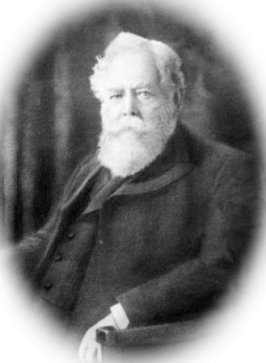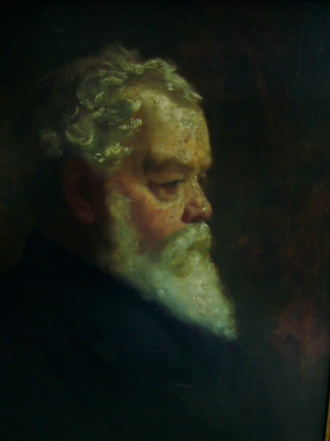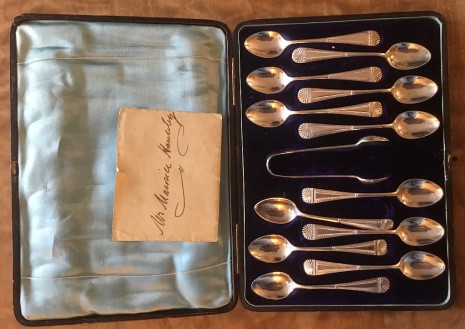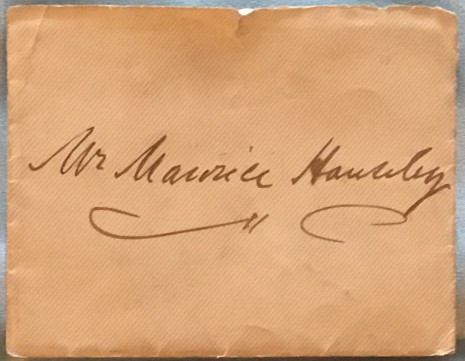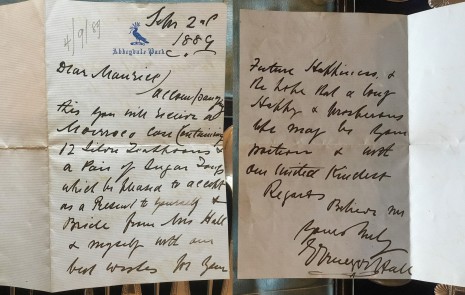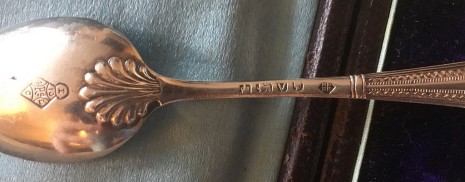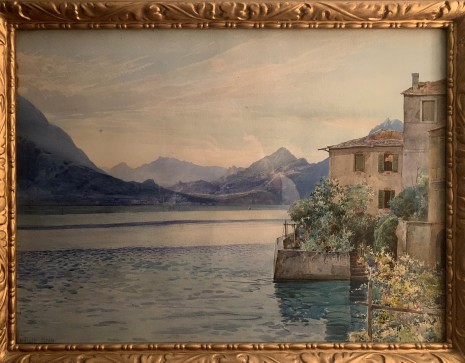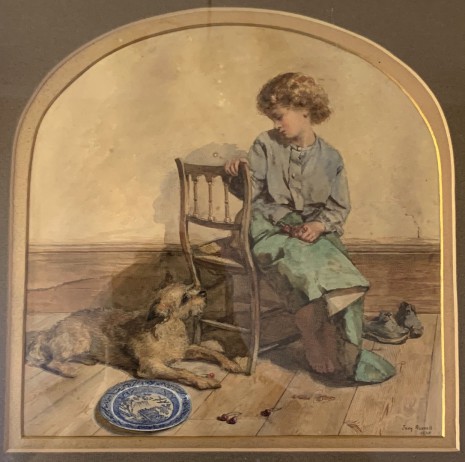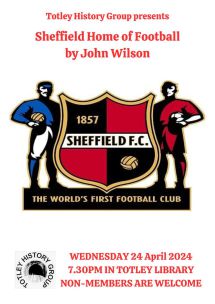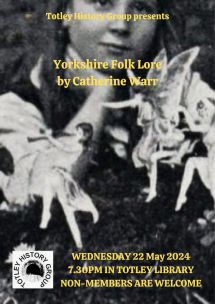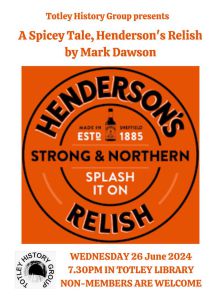Ebenezer Hall: Grand Old Man of Abbeydale
Ebenezer Hall was born in Middleton by Wirksworth, Derbyshire, on 18 November 1820 and baptized at St. Mary's Church, Wirksworth on 11 May 1823. He was named after his great-grandfather, Ebenezer Hall (1735-1803) and was the third of twelve children born to Gilbert Hall, a lead miner, and his wife Elizabeth (nee Slack): Ann (b. 1816), John (b. 1818), Ebenezer (b. 1820), Joshua (b. 1823), Job (b. 1825), Joseph (b. 1827), Daniel (b. 1829), Stephen (b. 1832), Sarah (b. 1834), Benjamin (b. 1836), Samuel (b. 1839) and David (b. 1842).
A very bright boy, he attended Cromford School and was recommended by the headmaster, William Shaw, to his friend John Roberts, a childless Sheffield silversmith who wished to adopt a promising young man to succeed to his silverplating business. So in 1836, at the age of 16, Ebenezer was apprenticed to the firm of Wilkinson & Roberts and he went to live with his employer, John Roberts and his wife Sarah at their home in Shrewsbury Road, in the Park district of Sheffield. During the next eleven years Ebenezer worked well becoming a manager for the firm and travelling on arduous stagecoach journies to London, Edinburgh and elsewhere. When his original partner Henry Wikinson retired in 1847, Roberts offered to take Ebenezer into partnership and the firm was renamed Roberts & Hall.
Roberts's contribution to the partnership of £2,750 greately exceded the £100 staked by Ebenezer Hall, who agreed to have his profits retained by the firm until they reached parity with his senior partner. Evidently, this arrangement gave Ebenezer further incentive to succeed. The firm prospered, exhibiting at the Great Exhibition of 1851 where they were awarded a Certificate of Merit.
In 1852 Roberts & Hall amalgamated with Martin & Naylor of Fargate, Sheffield and became known as Martin, Hall & Co. Around this time several of Ebenezer's brothers John, Joshua and Job all joined the firm, becoming departmental managers. Joshua Hall became a partner in the firm around the year 1857 but he died on 12 June 1861, aged 38, after a protracted illness. Some of Ebenezer's nephews also joined the firm, prominent among whom was his namesake, the son of his elder brother John Hall.
Ebenezer Hall first went into land purchase in 1849, when he bought a plot near Mickley Lane. In 1851, John Roberts bought a house on Abbeydale Road called Abbeydale Villa - later to be known as Abbeydale Hall; he also bought a large amount of land on both sides of Baslow Road. Ebenezer moved into Abbeydale Hall with John Roberts and his wife. In 1867 Ebenezer made a large purchase of land in Totley including Greenoak House for £10,000. The following year he took up his first public appointment as a Trustee for Cherrytree Orphanage.
Both Roberts and Hall were regular church attenders and felt the need for a religious outlet in their area. The cornerstone of St John's Church was laid in 1873, Roberts giving the land and £5,000 for the building. The endowment fund for the church of £2,000 was made up of contributions of £1,150, £550 and £300 from Roberts, Hall and the Duke of Devonshire respectively. Ebenezer Hall also made a substantial contribution towards the erection of the Vicarage.
Ebenezer continued to live as a boarder at Abbeydale Hall after the death of Sarah Roberts on 9 November 1874 and on 17 February 1876 he married Sarah Wilkinson in London at St. Paul's, Covent Garden. Sarah was the daughter of the late George Wilkinson and had been living at Abbeydale Hall for some years as a companion to her aunt Sarah Roberts. The service was conducted by Rev. J. T .F. Aldred, the vicar of Dore, assisted by Rev. H. B. Wilkinson of Sharnbrook, Bedfordshire, brother to the bride. Their honeymoon was delayed until 1879 when the couple visited Australia but this was thought to be as much to do with business as with pleasure. The couple attended the Sydney Exhibition where Martin, Hall & Co. won the highest award of merit.
In 1880 Ebenezer bought the Abbeydale Park Estate from the aged John Roberts who continued to live there with Ebenezer and Sarah Hall until his death on 11 April 1888.
After Martin, Hall & Co. became a limited company, Ebenezer had more time to pursue other business interests by taking directorships of several other companies, including those of Sanderson Brothers & Newbould Ltd., Sheffield and Rotherham Joint Stock Banking Co. Ltd., Sheffield United Gas-Light Company and Eyam Mining Company. He was also appointed a Derbyshire Magistrate in April 1884 but doesn't appear to have been very active in that role for very long. Although a strong Conservative, he took no prominent part in politics and sought no municipal role. In his younger days he had been a well-known sportsman, regularly following hounds, and enjoying a day's fishing. He was one of the earliest members of the Sheffield Book Club and a frequenter of the Sheffield Club. He was also a knowledgeable collector of paintings and a member of the Council of the Sheffield School of Art for five years between 1877 and 1881.
In 1881 Ebenezer had paid £2,460 for the Totley Rolling Mills including 6 cottages and a little over 8 acres of land on both sides of Baslow Road at Totley Rise. From the price paid it would appear that he bought it as a going concern but it would seem that the business did not survive the economic downturn for very long as the mill ponds had been filled in before the 1896 Ordnance Survey was made.
In 1883 his longstanding arguments with the Midland Railway Company began, over the passage of the new line through his estate. Ebenezer owned about 60 acres of land at Abbeydale Park, including nearby Brinkburn Grange and West View Cottage. After a legal wrangle lasting five years, the select committee declined to accede to Ebenezer's petition for a tunnel to mitigate the effects of the railway and on 18 June 1886 the Dore and Chinley Railway Bill finally became enacted and Ebenezer was obliged to sell about 30 acres of his estate to the railway company. Despite these aggravations, Ebenezer was on a committee to provide mission work among the labourers employed on the Dore & Chinley Railway and to assist the local schools, whose finances were being drained by the increased numbers of children from the huts of the navvies.
His other charitable works included membership of the Management Committee of the Charity School for Poor Girls in Sheffield, for which both he and his wife gave £2 2s. 2d annually. In 1893 he gave £3,000 for Church rooms for St John's and further money for the improvement of the Church. When the foundation stone of the new chancel of Dore Church was laid he gave an inscribed silver trowel. Later he donated £50 towards a new organ for Dore Church and further money to augment the stipend of the Vicar of Dore. In 1895, when the Wesleyan Methodists of Totley Rise wanted to build a new church, Ebenezer gave them free of charge a plot of 1,500 square yards from the parcel of land he had bought at Totley Rolling Mill.
Ebenezer Hall left an estate valued at £194,632 18s. 3d. After provision for his wife's relatives and friends, from his Residuary Fund he left money for the Sheffield Royal Infirmary (£300), Sheffield Royal Hospital (£500), Sheffield Children's Hospital (£250), Sheffield Jessop's Hospital (£250), Sheffield Nurses Home and Training Institution (£100), Sheffield Boy's Charity School (£200), Sheffield Girl's Charity School (£300), Totley Cherrytree Orphanage (£350) and Wirksworth Hospital (£250). He left money to the Vicar and Churchwardens of Middleton-by-Wirksworth, Totley, Dore and Holmsfield to buy governmental stock to produce a yearly sum for the benefit of the poor. St John's, Abbeydale benefited by £3,000 to be spent on the church as did to a lesser extent the Churches of Middleton in Wirksworth (£2,500) and St John's, Park (£300).
Ebenezer Hall in Public Records
Births, Marriages and Deaths
| Name | Event | Place | Registration Date | Age |
|
Ebenezer Hall |
Birth
|
Middleton by Wirksworth, Derbyshire
|
18 Nov 1820
|
|
|
Ebenezer Hall |
Baptism
|
St. Mary's Church, Wirksworth, Derbyshire | 11 May 1823 | 2 |
|
Sarah Ann Wilkinson (wife) |
Birth
|
Middlesex, London
|
c. 1836
|
|
|
Ebenezer Hall and Sarah Ann Wilkinson |
Marriage
|
St. Paul's, Covent Garden, London
|
17 Feb 1876
|
55
|
| Ebenezer Hall |
Death
|
Abbeydale Park, Dore, Derbyshire |
28 Jun 1911
|
91
|
|
Ebenezer Hall |
Burial
|
General Cemetery, Sheffield |
1 Jul 1911
|
|
|
Sarah Ann Hall (wife)
|
Death
|
Imperial Hotel, Llandudno, Caernarvonshire |
30 Jul 1919
|
84
|
|
Sarah Ann Hall (wife) |
Burial
|
General Cemetery. Sheffield |
2 Aug 1919
|
1851 Census, Commercial Hotel, Old Town Street, St. Andrew, Plymouth, Devon
| Name | Relation | Condition | Age/Born | Occupation | Birthplace |
| Francis H. Chubb |
Head
|
Married
|
33 c. 1818 |
inn keeper
|
Devon, Lamerton |
| ... and others | |||||
|
Ebenezer Hall |
Visitor
|
Unmarried
|
30 c. 1821 |
silver plater
|
Yorkshire, Sheffield |
1861 Census, Abbeydale Villa, Dore, Derbyshire
| Name | Relation | Condition | Age/Born | Occupation | Birthplace |
| John Roberts |
Head
|
Married
|
63 c. 1798 |
gentleman
|
Sheffield, Yorkshire |
| Sarah Roberts |
Wife
|
Married
|
55 c. 1806 |
Sheffield, Yorkshire | |
| Sarah Wilkinson |
Visitor
|
Unmarried
|
26 c. 1835 |
London
|
|
| Ebenezer Hall |
Boarder
|
Unmarried
|
40 c. 1821 |
silver plater
|
Middleton
|
| Ann Ashmore |
Servant
|
Unmarried |
35 c. 1826 |
housekeeper and cook | Brightside, Yorkshire |
|
Jane Smith
|
Servant
|
Unmarried
|
25 c. 1836 |
housemaid
|
Lancashire
|
| Elizabeth Smith |
Servant
|
14 c. 1847 |
kitchen maid
|
Gainsbrough, Yorkshire |
1871 Census, Abbeydale Park, Dore, Derbyshire
| Name | Relation | Condition | Age/Born | Occupation | Birthplace |
|
John Roberts
|
Head
|
Married
|
73 c. 1798
|
farmer of 105 acres employing 4 men and aboy |
Sheffield, Yorkshire
|
| Sarah Roberts |
Wife
|
Married
|
66 c. 1805 |
Sheffield, Yorkshire | |
| Ebenezer Hall |
Boarder
|
Unmarried
|
50 c. 1821 |
silversmith
|
Middleton, Derbyshire |
| Sarah Ann Wilkinson |
Cousin
|
Unmarried
|
36 c. 1835 |
companion
|
London, Middlesex |
| Hannah Carter |
Servant
|
Unmarried
|
33 c. 1838 |
cook
|
Ambergate, Derbyshire |
| Fanny Richardson |
Servant
|
Unmarried
|
25 c. 1846 |
housemaid
|
Ambergate, Derbyshire |
| Mary Ann Robinson |
Servant
|
Unmarried
|
20 c. 1851 |
housemaid
|
Totley, Derbyshire |
| Louisa Redfern |
Servant
|
Unmarried
|
16 c. 1855 |
housemaid
|
Sheffield, Yorkshire |
1881 Census, Abbeydale Park The Hall, Dore, Derbyshire
| Name | Relation | Condition | Age/Born | Occupation | Birthplace |
|
Ebenezer Hall
|
Head
|
Married
|
60 c. 1821
|
managing director, silversmiths and electro platers |
Middleton, Derbyshire
|
| Sarah Ann Hall |
Wife
|
Married
|
45 c. 1836 |
London, Middlesex | |
| John Roberts |
Resident
|
Widower
|
83 c. 1798 |
retired manufacturer |
Sheffield, Yorkshire |
|
Mary Hustice (Anstiss) Hendy |
Visitor
|
Unmarried
|
19 c. 1862
|
|
Trowbridge, Wiltshire
|
| Fanny Marshall |
Servant
|
Unmarried
|
24 c. 1857 |
parlourmaid
|
Retford, Lincolnshire |
| Elizabeth A. Baines |
Servant
|
Unmarried
|
24 c. 1857 |
housemaid
|
Gainsborough, Lincolnshire |
| Florence Eleanor Hall |
Servant
|
Unmarried
|
19 c. 1862
|
housemaid
|
London, Middlesex
|
|
Mary Ellis
|
Servant
|
Unmarried
|
19 c. 1862 |
kitchenmaid
|
Selstone, Derbyshire |
1891 Census, Abbeydale Park, Abbeydale Road, Dore, Derbyshire
| Name | Relation | Condition | Age/Born | Occupation | Birthplace |
|
Ebenezer Hall
|
Head
|
Married
|
70 c. 1821
|
magistrate not in buiness |
Middleton by Wirksworth, Derbyshire |
| Sarah Ann Hall |
Wife
|
Married
|
55 c. 1836 |
London, Middlesex | |
| Edwin James Roberts |
Visitor
|
Single
|
30 c. 1861
|
silversmiths clerk
|
Lancashire, Liverpool
|
|
Sarah Bouldin |
Servant
|
Single
|
35 c. 1856
|
cook
|
Yorkshire, Walkley
|
| Charlotte Ann Womack |
Servant
|
Single
|
26 c. 1865
|
housemaid
|
Yorkshire, Stannington
|
|
Maria Hewitt |
Servant
|
Single
|
24 c. 1867 |
housemaid
|
Derbyshire, Brimmington |
|
Lucy Hannah Merton |
Servant
|
Single
|
21 c. 1870
|
housemaid
|
Derbyshire, Totley Bents
|
|
Ellen Thirza Barnsdall |
Servant
|
Single
|
21 c. 1870
|
kitchenmaid
|
Yorkshire, Sheffield
|
| Charles Joseph Attakbury |
Boarder
|
Single
|
18 c. 1873
|
silversmiths apprentice
|
Nottinghamshire, Sutton On Trent
|
1901 Census, Abbeydale Park, Dore, Derbyshire
| Name | Relation | Condition | Age/Born | Occupation | Birthplace |
|
Ebenezer Hall |
Head
|
Married
|
80 c. 1821 |
living on own means |
Wirksworth, Derbyshire |
| Sarah A. Hall |
Wife
|
Married
|
65 c. 1836 |
London
|
|
| Maria J. Beck |
Wife's Sister |
Widow
|
55 c. 1846 |
living on own means |
London
|
|
Mary Corsaw |
Visitor
|
Single
|
71 c. 1830 |
living on own means |
Yorkshire, Sheffield |
| Susan Johnson |
Servant
|
Single
|
28 c. 1873 |
cook
|
Yorkshire, Sheffield |
|
Elizabeth A. Surridge |
Servant
|
Single
|
27 c. 1874
|
parlourmaid
|
Northampton- shire, Wellingboro' |
|
Emily Frith |
Servant
|
Single
|
22 c. 1879 |
housemaid
|
Derbyshire, Dore |
|
Louisa J. Surridge |
Servant
|
Single
|
18 c. 1883 |
housemaid
|
Bedfordshire, Ludwell |
| Ruth A. Hinchcliffe |
Servant
|
Single
|
22 c. 1879 |
kitchenmaid
|
Yorkshire, Sheffield |
1911 Census, Abbeydale Park, Dore, Derbyshire
| Name | Relation | Condition | Age/Born | Occupation | Birthplace |
|
Ebenezer Hall
|
Head
|
Married
|
90 c. 1821
|
retired silver plate manufacturer |
Middleton, Derbyshire
|
| Sarah Ann Hall |
Wife
|
Married
|
75 c. 1836 |
London
|
|
| Maria J. Beck |
Sister
|
Widow
|
65 c. 1846 |
|
London
|
|
Mary Anstiss Hendy |
Niece
|
Single
|
48 c. 1863
|
|
Wiltshire, Trowbridge
|
|
Emma Bell |
Cert. Nurse |
Single
|
52 c. 1859 |
certified nurse |
Weston Super Mare |
| Miranda Mary Wilkinson |
Niece
|
Single
|
21 c. 1890
|
Oxford student
|
Bedfordshire, Sharnbrook
|
| Susan Johnson |
Domestic Servant |
Single
|
38 c. 1873 |
cook
|
Yorkshire, Sheffield |
|
Minnie Storer |
Domestic Servant |
Single
|
34 c. 1877 |
parlourmaid
|
Yorkshire, Sheffield |
|
Lily Woodcock |
Domestic Servant |
Single
|
26 c. 1885 |
head housemaid |
Yorkshire, Rotherham |
|
Hilda Nendick |
Domestic Servant |
Single
|
19 c. 1892 |
2nd housemaid |
Yorkshire, Sheffield |
| Annie Kinman |
Domestic Servant |
Single
|
17 c. 1894 |
3rd housemaid |
Yorkshire, Sheffield |
| Rose Dyson |
Domestic Servant |
Single
|
22 c. 1889 |
kitchenmaid
|
Yorkshire, Sheffield |
Wills and Probate
Hall Ebenezer of Abbeydale Park Dronfield Derbyshire esquire died 28 June 1911 Probate Derby 10 August to Samuel Clark Shaw Hall silversmith Alfred Ernest Maxfield solicitor and Arnold Thomas Watson accountant and sharebroker. Effects £194632 18s. 3d,
Ebenezer's Gift
We are enormously grateful to a correspondent in Canada for sending us these images of a set of silver spoons that were bought in a small town in British Columbia.
We have tried to find out more about their history and provenance using as a starting point the handwritten note inside the case. It reads:
Abbeydale Park
July 2nd 1889
Dear Maurice,
Accompanying this you will receive a Morocco case containing 12 Silver Teaspoons & a Pair of Sugar Tongs which be pleased to accept as a Present to yourself &
Bride from Mrs Hall & myself with our best wishes for your Future Happiness, & the hope that a long, Happy and prosperous life may be your .... & with our united Kindest Regards
Believe me
Yours truly
Ebenezer Hall.
Envelope addressed to Maurice Housley
The spoons are hallmarked Sheffield 1888 by Martin Hall & Co. Ltd., Ebenezer's own silverware company. We have tried to verify the signature on the note but the only other signature that we have is from his marriage register entry and there does seem to be some deterioration in his handwriting between 1876 and 1889. The note was probably written in haste but we have no doubt whatever that it is authentic. The fact that it has been kept together with the spoons immediately suggests that they have remained in the same family for most of the time.
The recipients of the gift were Maurice Housley and his future wife Fanny Ada Pennington who married on 3 September 1889 at St. George's Church, Brook Hill. Sheffield. Maurice was born in Sheffield in 1864, the youngest of three sons of George Housley, the General Secretary of the Operative Bricklayers Society, and his wife Mary Ann Taylor who married on 24 December 1854, also at St George's. Fanny was born in 1860 in Sheffield, the second of three children of George Pennington, a joiner and builder, and his wife Mary Ann Cocking who married in 1856.
We have not yet found a definite connection between Ebenezer and the Housleys. George Housley lived on Abbeydale Road during the 1880s, near what became the Beauchief Hotel. He and his family may have become known to Ebenezer through business, church or one of his many other social interests. The spoons are a superb gift, given by a man who was well known for his generosity, particularly to local causes and local people.
Maurice and Fanny had four children: Dorothy (1893), Winifred Pennington (1894), Laurence George (1898) and Eric (1900), all born whilst they were living at 74 Charlotte Street, Highfield in the heart of Sheffield's cutlery and edge tool quarter. Maurice was a steelmaker's correspondence clerk. From their children's school records we know that by 1905 the family had moved to 105 Melford Road, Thornton Heath, Surrey. It looks like Maurice was transferred to work in Croydon or London as he was still a steelmaker's clerk in the 1911 Census. Maurice and Fanny lived at that address for the rest of their lives. Maurice died on 7 January 1921, aged 56 and Fanny on 14 March 1922, aged 62.
Daughter Dorothy became a school teacher in Brighton before marrying Francis James Gibbins in 1919. She lived in Surrey and Sussex all her married life and died in Chichester, West Sussex in 1954. Winifred never married and died in Worthing, West Sussex in 1956. Laurence became a bank clerk. He married Emma Thelma Dorothy Horne in Richmond, Surrey in 1934 and died in Ewell, Surrey in 1966.
Eric Housley served in the army and later in the RAF towards the very end of World War One. After the death of his parents, he emigrated to Canada aboard the SS Montlaurier arriving at St. John's, New Brunswick on 15 March 1924. Accompanying him on his voyage were his future wife, Dorothy Edith, and her brother George Dudley. They were the only children of George Stephens, a wholesale warehouseman, and his wife Edith Eveline Smith who had married at Lambeth in 1898. Dorothy was born in 1901 in Kingston Upon Thames and George in 1903 in Tolworth, both in Surrey.
Their Canadian immigration forms shows that they intended to join a Mr A. Tyrrell at 130 Joseph Street, Ross Bay, Victoria, British Columbia (B.C.). Alfred Tyrrell was Dorothy's uncle, having married Florence Rose Smith on 16 April 1897 at Holy Trinity, Tulse Hill, Surrey. Alfred and Florence had emigrated to Canada in 1921 together with their six children.
Eric and Dorothy were married on 20 September 1925 at Christ Church Cathedral, Victoria. The witnesses were Dorothy's brother George and her cousin Florence Hilda Tyrrell. It seems safe to assume that the set of silver spoons had been given to the couple by the Housley family as a wedding present and a memory of home. They would be small and light and easily carried with them on their passage to Canada.
Eric Housley died on 10 June 1957 at Saanich, B.C. aged 57. Dorothy appears to have been living in Victoria City in 1972 but we have not been able to trace her death or whether there were children from the marriage. Her brother George married Florence Lilian Thompson on 15 September 1928 at Oak Bay, B.C. He died on 13 May 1972, aged 69, and Florence on 27 March 2006, aged 99, both in Victoria, B.C. Again, we do not know whether they had any children. It seems fair to conclude that the set of spoons have spent 96 of their 132 years of existence in Canada and the vast majority of that time they have been in the hands of the same family.
August 2020
Ebenezer's Pictures
We are extremely grateful to Anton Rodgers for sending us photographs of three water-colour paintings which his grandfather bought at a sale of the contents of Abbeydale Hall following the death of Ebenezer Hall's widow, Sarah Ann (née Wilkinson) on 30 July 1919.
The sale took place on 4 December 1919 at the auction rooms of Bush & Co., Church Street, Sheffield. There was a large attendance and competition for some of the works was keen although the prices were not uniformly high. Every lot was sold. The highest prices were paid for works by Henri Fantin-Latour (460 guineas) and Thomas Sidney Cooper (360 guineas).
Anton was quick to say his grandfather's pictures were not in that league but the two that we have chosen to show here are certainly attractive. The painting below is called Lake Como and is signed by Ainslie Bean. It was bought with its existing gilt frame.
Ainslie Bean was born at Gosden Cottage, Westbourne, West Sussex on 10 July 1851, the youngest of eleven children of Felix Freeman Frederick Bean, a landowner of independent means, and his wife Frances Walker, who married on 14 August 1828 at St. Nicholas, Brighton. He was baptised Ainsley Hodson Bean at St. John the Baptist, Westbourne on 27 August 1851.
Felix Bean came from a military family. He had purchased a commission as an Ensign in the Sussex Regiment of Militia on 2nd May 1820 and on 22 August 1825 he had been elevated to the rank of Captain. Felix died when Ainsley was only five years old in tragic circumstances. Whilst visiting a married daughter who lived in Egglescliffe, Durham, he took his own life with a razor.
By the time of the 1861 Census Ainslie was the only child left at home with his mother who was now living at 6 Chichester Villas, Paddington. He was educated at Gibraltar College in Monmouth. On 2 April 1864 the baptism register of St. Cenedlon, Rockfield, Monmouthshire shows that Ainslie was admitted to the Church under the name Ainslie Hodson Willard Bean. After leaving college, Ainslie and his mother appear to have spent most of their time together travelling in Europe, particularly in the Riviera and in North Italy.
Ainslie converted to Catholicism and on 5 May 1880 was baptised for a third time at the Church of Our Lady of Victories, Kensington under the name Wilfred Ainslie Hodson Willard Bean. Frances and Ainslie sometimes spent two or three months together in British seaside hotels. Frances Bean died on 1 January 1891 in Florence aged 81 although before that she and Ainslie had been living in Vevey on Lake Geneva.
Ainslie's paintings first came to the attention of the national press in November 1894 at an exhibition at the Japanese Gallery in New Bond Street. It was widely advertised under the title of Riviera and North Italy: 97 Water-Colour Drawings by Ainslie Bean. Admission was a shilling including programme. His work was described as bold, bright and pleasing and received favourable reviews by most newspaper art critics. The subject matter held a fascination for many people. Some were becoming familiar with the Italian Lakes and Riviera. Many more wished they were.
A second London exhibition was held at St. George's Gallery, Grafton Street in April 1897 showing new paintings which were again chiefly of Italian scenery and included a work catalogued as View from San Giovanni, Lake Como. Again the reviews were predominantly favourable although the art critic of The Pall Mall Gazette remarked that "one might get a better impression of Mr. Ainslie Bean's work if the show were weeded and reduced by a third."
After that it would appear that Ainslie's paintings were exhibited mainly at small art exhibitions in Sussex and Kent where he appears to have been a member of the Folkestone Art Club. That is until in April 1914 when an exhibition at the Graves Galleries, Pall Mall, entitled Venice and the Italian Lakes combined Ainslie's works with those of another water-colour artist, Pownoll Williams. In later life, Ainslie styled his name Ainsliè Hodson Bean. He died on 10 December 1918 at 8 Via San Basilio, Rome. He was aged 67 and unmarried.
This second picture is called Cherries and is dated 1865. It is signed "Juey Russell", believed to be a short form for Juliana Russell, a water-colour artist who was producing similar compositions at this time.
Juliana Russell was born in Notting Hill, London on 4 January 1841 and baptised on 15 April at St. Mary Abbots Church, Kensington. She was the fourth of nine children of Henshaw Skinner Russell, and his wife Sarah Church who married on 29 October 1834 at St. Mary, Streatley in Berkshire. Henshaw's father, John Russell, had paid for him to become an solicitors clerk, articled to William Graham of Abingdon. Henshaw qualified as a solicitor the year after his marriage.
Sarah and Henshaw's first five children were all girls: Anna (born in 1836), Eleanor (1838), Sarah Anne (1839), Juliana (1841) and Janette Catherine (1842). Three sons followed but they all died as infants. Daughter Rose Agatha was the ninth and youngest child in 1849. All the children were born in St. Marylebone, Middlesex except for Juliana and Janette who were born in Notting Hill when the family were living at Holland Park Terrace. Henshaw worked at 2 Mitre Chambers, Temple from 1843 and possibly earlier. By the time of the 1851 Census, the Russells had moved to The Priory, Victoria Road, Surbiton. It would remain the family home for the next seventy years. Anna, the eldest daughter, died there on 7 May 1852, aged 16.
From a very early age Juliana had shown a remarkable talent for art. At age 12 she had drawn 23 sacred subjects for the east window of St. Mark's Church in Surbiton and from their success was asked to do designs for other churches. She also drew three subjects on stone from which lithographs were produced and sold to raise funds for the pulpit at St. Mark's, Easton, Bristol.
Juliana and her younger sister Janette studied at Thomas Heatherley's School of Fine Art in Newman Street and later at the Bristol Fine Arts Academy. They had relatives in the Bristol area and in 1861 were living with their unmarried aunts Maria and Caroline Russell at 9 Guildford Villas, Clifton.
Juliana's paintings appeared regularly at the Bristol Academy's exhibitions between 1863 and 1870. The subjects were very largely taken from novels, plays, poems and songs and included Virginia's Hand (from a novel by Marguerite Agnes Power), Desdemona and Emilia (from Shakespeare's Othello), Annie (from Tennyson's Enoch Arden), The Lady of the Lea (from a popular song), Isabella and the Basil Pot (from Keats), and The Faire Christabelle (from a traditional folk song). Her pictures were described as full of vigorous vitality of style.
Juliana had returned to The Priory by 1871 but she never lost contact with Bristol. She was elected a member of its Fine Arts Academy in 1875 and donated several works to it throughout the rest of her life. Her mother died on 24 January 1885 aged 77 and father on 29 January 1891, aged 82. In the 1891 Census whilst her sisters Eleanor, Sarah, Janette and Rose were still living at The Priory in Surbiton, Juliana was living with a servant, at 53 Upper Belgrave Road, Clifton. She died at The Priory on 19 November 1898. She was aged 57 and, like her four surviving sisters, unmarried.
Juliana's paintings were well known in London where they were frequently exhibited at the Dudley Gallery of Water-colours, Piccadilly. They were also exhibited at the Royal Academy and at provincial art galleries. In the June following her death, an exhibition of her work took place at 1 Harewood Place, Hanover Square with paintings loaned by both private and public collectors.
September 2020
Search Our Website Here
Future Meetings
April
May
June
Unless stated otherwise our meetings are held in Totley Library on the 4th Wednesday of each month at 7.30pm.
Pauline Burnett's book The Rise of Totley Rise has been revised and updated. It tells the story of this small piece of land from 1875 when there was only a rolling mill and chemical yard alongside the river a mile from Totley, through Victorian and Edwardian times, two world wars and up to the present day. It has 94 pages including a useful index and many illustrations from private collections. The book is available now from Totley Rise Post Office priced at £5, or through our website when an additional charge will be made to cover packing and postage.
A few copies are still available of Sally Goldsmith's book Thirteen Acres: John Ruskin and the Totley Communists. Totley was the site of a utopian scheme funded by art critic and social reformer John Ruskin. In 1877 he bought 13-acre St. George’s Farm so that nine Sheffield working men and their families could work the land and, to keep themselves busy, make boots and shoes. Sally tells an engaging story from our history with a quirky cast of characters including Ruskin himself, the poet and gay rights activist Edward Carpenter and Henry Swan, a cycling, vegetarian artist and Quaker. The book is available to order online from the The Guild of St. George by following this link.
A recently discovered box of WWII correspondence reveals the story of how a small group of ladies from Dore and Totley recruited knitters from the west of Sheffield and how their efforts made them the country's greatest provider of Comforts for the Minesweeping crews of the Royal Navy. The story is told in Knit For Victory, a new book from Totley History Group. Written by Pauline Burnett, it has 82 pages and many illustrations. It is on sale in local shops and via our website. Further information about the correspondence is in this inside page of our website: Dore & Totley Minesweeping Trawlers Comforts Fund.
The story is told in Totley War Memorial WW1 of the ten men from our village who gave their lives in the Great War. Written by Pauline Burnett, Jim Martin and Dorothy Prosser, a chapter is devoted to each of the soldiers with a family tree followed by as much information as could be discovered about the men and their families. There is also information about their military careers and the actions in which they lost their lives. The book has 64 pages and is illustrated throughout with photographs of the men, their families and the houses where they lived.
Totley All Saints' Church Parish Magazines for the years 1985-2006 with notices of baptisms, marriages and funerals and accounts of spiritual, educational, charitable and social matters in the village. Scanned in full, including advertisements from local traders.
In 1893 during the building of the Totley Tunnel there was an outbreak of smallpox amongst the navvies which spread to some of the local population. 17 people were buried in communal graves in Dore Churchyard, 6 from "Green Oak" (Lemont Road). The severity of the outbreak was principally caused by overcrowding and insanitary conditions in lodging houses .
Kathleen Grayson was a 39 year old housewife when WW2 broke out. She volunteered for the ARP and became an ambulance driver. During an air raid on Sheffield in July 1941, and despite her own injuries, she managed to get a seriously injured casualty to hospital. For this she was awarded a commendation from King George VI. Together with her friend Hilda Duffy, Kathleen also assembled a team of knitters to provide essential warm clothing for the men serving on the minesweepers patrolling the North Sea.
We have recently bought at auction the WW2 memorabilia of Douglas Platts whose family home was at Hillside, 98 Queen Victoria Road. After the war Douglas returned to his civilian occupation working in the family scissors manufacturing business. He lived in our area for the rest of his life.
We are very grateful to Mrs Valerie Taylor of Dore for lending us the title deeds to Lower Bents Farmhouse which is reputed to be the oldest surviving building in the area with a proven history back to 1621. We have now scanned and transcribed the deeds which could be particularly interesting to anyone with a connection to the local Fisher, Dalton and Marshall Families.
Until 1844, when Dore Christ Church parish was created, Totley township was part of Dronfield parish. We have now transcribed the burial records for former Totley residents at St. John the Baptist, Dronfield for the period 1678-1870 and at St. Swithin, Holmesfield for the period 1766-1901.
Whilst researching the history of the Dalton Family we found it useful to transcribe a number of early Wills and Inventories. These and those of many other Totley, Dore and Holmesfield people dating from between 1594 and 1856 have now been added to our website.
St. Swithin's Church, Holmesfield pre-dates Dore Christ Church and was the place where many of the people from Totley worshipped and were baptised, married and buried. Read the inscriptions on more than 750 gravestones in the churchyard including those of Mr. and Mrs. William Aldam Milner of Totley Hall, Jessie Matilda Tyzack (nee Fisher) of Avenue Farm, and Rev. J. A. Kerfoot of St. John's, Abbeydale.
Thomas Youdan was a music hall proprietor and benefactor who was living at Grove House, Totley in 1867 when he sponsored the first football knockout competition in the world for The Youdan Cup.
The words Millhouses Cricket Club can be seen in the background of team photos which are likely to date from between 1905 and the early 1920s, very probably pre-war. They were lent to us by Garth Inman who can identify his great uncle, Cecil Inman, in some of the photos and would like to know when they were taken and, if possible, the names of others present. Please take a look to see whether you can put names to any of the faces.
Josiah Hibberd was seriously injured whilst working on the construction of the Totley Tunnel in 1892. He died on 9 May 1897 at the age of 38 having apparently spent most of previous five years in hospital.
Bradway House was built around 1832 by Henry Greaves, a farmer, together with two adjacent cottages. We have traced most of the occupants of the property from these early days up to the start of World War Two.
We have transcribed the baptisms records at St. John the Evangelist, Abbeydale from when the church was consecrated in 1876 until just after the start of World War 1. The records are arranged in alphabetical order based upon the child's name and show the date of baptism, the names of the parents, their home location and occupation.
Nick Kuhn bought an original 1920s poster which had this owners' blind stamp in one corner. The stamp almost certainly refers to a house named Wigmore that was built in the late 1920s or early 1930s. The first occupiers that we can trace are John Howarth Caine, a district mineral agent for the LNER, his wife Florence Jane (nee Prince) and daughter Doris Mary. The Caine family lived at Wigmore until 1936 by which time the house would have been known simply as 12 The Quandrant.
George Griffiths died on 13 December 1888 following an explosion during the sinking of number 3 airshaft at Totley Bents. His widow Florence died shortly afterwards and his two daughters Maud and Annie were adopted separately. Whilst Annie lived the rest of her life in Yorkshire, Maud emigrated to Australia in 1923 with her husband, John Burrows, daughter Margaret and son Jack, pictured above.
George Wainwright was said to have been born in Bamford, Derbyshire in 1714. He learned the trade of linen weaving and moved to Totley after his marriage on 1744. He became an ardent follower of John Wesley who paid many visits to Sheffield and who would have passed through or close to Totley. Preaching was at first conducted out of doors and when Wesley's preachers became harassed by a mob of Totley ruffians in 1760, George offered them safety of his own home. He remained a Methodist for all of his long life, dying in Dore in 1821 at the reputed age of 107.
Oakwood School was started by Mrs Phoebe Holroyd in 1925 initially as the Firth Park Kindergarten and, by 1927, as the Firth Park Preparatory School. Phoebe was still working at the school almost fifty years later when she was well into her seventies. We would like to hear from anyone with memories of the school.
James Curtis was born at sea aboard HMS Chichester in 1790. He enlisted as a Private in the 1st Grenadier Regiment of Foot Guards in Sheffield in 1812 and served in Spain and Portugal during the Peninsular War. He later fought in France and Belgium taking part in the Battle of Waterloo. In later life James lived at the Cricket Inn where his son-in-law William Anthony was the licensed victualler. He died in Heeley in 1882 aged about 91.
Charles Paul lived in Totley in later life. He was a local historian and archaeologist who was an authority on the history of Sheffield, especially the two areas he knew best: Attercliffe and Ecclesall. His books and letters to local newspapers were published under the Latin form of his name Carolus Paulus.
Towards the end of the 19th century Totley Hall gardens became a well known beauty spot that attracted many hundreds of visitors from Sheffield on open days and the rock gardens became one of its most popular features. Mrs Annie Charlesworth sent us six glass transparencies of the rock gardens taken, we believe, in the early years following the Great War.
Anton Rodgers send us photographs of three water-colours that had been bought by his grandfather at a sale of the contents of Abbeydale Hall in 1919. One was of a scene said to be in York by A. Wilson. A second was of a seated child with a dog believed to be pianted by Juliana Russell (1841-1898). The third was of Lake Como, by Ainslie Hodson Bean (1851-1918) who lived for much of his life on the Riviera and in North Italy.
A Canadian correspondent sent us photographs of a set of silver spoons that were bought in a small town in British Columbia. The case contained a note signed by Ebenezer Hall indicating that they were a wedding gift to Maurice and Fanny Housley. We think we may have traced how they got to Canada and where they might have been since.
Green Oak Park was opened on 23 March 1929 on land that had been bought by Norton District Council from John Thomas Carr, a farmer and smallholder of Mona Villas. In later years, the buildings were used by the Bowling Club (the green having been built in 1956) and by the park keeper. However, the buildings appear to have been constructed in several phases, the oldest of which predates the park to the time when the land was used for pasture.
We believe the old Totley Police Station at 331 Baslow Road was built around 1882. Two lock-up cells were excavated just below floor level in the summer of 1890. We have traced the Derbyshire Constabulary police officers who lived there from John Burford in 1886 to George Thomas Wood who was there when Totley was absorbed into Sheffield in 1934.
David Stanley lived in Totley Rise in the later years of his life. Born in Bulwell, Nottinghamshire, he joined the 17th Lancers when he was 19 and rode in the Charge of The Light Brigade at the Battle of Balaclava where he was seriously wounded. For the first reunion of veterans in 1875, he told his story to a reporter from the Buxton Herald.
This picture postcard was addressed to Miss Abell, Holly Dene, Totley Brook Road and posted in Rotherham on 10 December 1907. Edith Annie Abell was born on 4 February 1887 in Sheffield and her family came to live in our area in the 1900s, staying for the rest of their lives.
Charles Herbert Nunn enlisted in the British Army on 23 August 1915 and was sent to France on 18 December 1915 to served with the British Expeditionary Force. In March 1916 it was discovered that he was underage and he was returned home. Shortly after his 18th birthday he re-enlisted and was again posted abroad where, in addition to this trio of medals, he was awarded the Military Medal.
This certificate was awarded jointly by the Red Cross and St. John's Ambulance to Isaac Henry Williams, of Lemont Road, for his services during WW1 as a stretcher bearer. We are seeking anyone who can help us pass it on to a living relative.
In 1832 Samuel Dean pleaded guilty to stealing a quantity of lead from the Totley Rolling Mill and was sentenced to seven years transportation to Australia. He sailed on the Mangles and upon arrival in New South Wales he was sent to work for William Cox, the famous English explorer and pioneer. After receiving his Certificate of Freedom in 1840, Samuel became a farmer and went on to have a very large family. Samuel was born in Whitechapel around 1811 to parents Samuel Dean Snr. and Susannah Duck. His descendant Sarah Dean would like help in tracing his ancestry.
Ellen Topham was born in 1889 in Nottingham. Her parents had been living together since 1862 but had never married so it was most unusual that, after their deaths, Ellen was accepted into Cherrytree Orphanage. Even more so since her father, Snowden Topham, had been acquitted somewhat unexpectedly in a widely reported manslaughter trial. Ellen remained at Cherrytree until her death from pulmonary tuberculosis at the age of 15.
Mabel Wilkes was a resident in Cherrytree Orphanage between 1897 and 1905. Her granddaughter Sally Knights sent us these images of a book presented to Mabel as a prize for her writing. Sally also sent us some personal memories of her grandmother and a photograph of a locket which contains portraits of Mabel and her husband Septimus Gale.
John Henry Manby Keighley was living at Avenue Farm when he enlisted in 1916. He fought in France with the Cheshire Regiment but after home leave in early 1918 he went missing. The Army were unable to determine whether he had deserted or returned to the front and been either killed or captured by the enemy. In August 1919 he was formally presumed killed in action but it appears he did not die but returned home to his family.
Horace Ford was admitted to Cherrytree Orphanage on 26 October 1888 at the age of six. He left at the age of 14 to become an apprentice blacksmith and farrier. Soon after his 18th birthday Horace enlisted in the Imperial Yeomanry to serve his country in the war in South Africa. His letter home to his Orphanage mentor tells of the lucky escape he had in battle.
Pat Skidmore (née Sampy) lived on Totley Brook Road from 1932 to 1948 before her family moved to Main Avenue. In this short article she remembers her time at Totley All Saints School where she was a contemporary of Eric Renshaw and Bob Carr.
As we have nowhere to exhibit memorabilia and artifacts, we have created a Virtual Museum instead. The latest addition to our collection is this double-sided Totley Rise Post Office oval illuminated sign which was on the wall of 67 Baslow Road before the Post Office business transferred to number 71. Please contact us by email if you have things that you own and would like to see added to the virtual museum.
Conway Plumbe was a man of many talents who came to live in Totley Rise around 1912. As a young man he had poems published by Punch magazine and is remembered in modern collections of WW1 poetry. A number of his paintings were accepted by the Royal Academy. An engineering graduate of London University, he joined the Civil Service where he rose to a high level as a factory inspector, publishing two books on the subject and giving a series of talks on workplace health and safety on BBC radio during WW2. In retirement he wrote a philosophical-spiritual work called Release From Time.
Inside Totley Rise Methodist Church there is a Roll of Honour commemorating the soldiers from its congregation who served their king and country during the Great War. For all but one of the 28 names the soldier's regiment is recorded in the next column. The exception is David Cockshott for whom 'killed in action' is written alongside yet he appears on no war memorial in our area and no record of a mortally wounded soldier of that name is to be found. We think we have solved the mystery.
Mrs. Kate Plumbe moved from Mansfield to Totley Rise with a number of her family in 1913 and became closely involved with the Totley Union Church. Her daughter Winifred became a missionary and headmistress in Calcutta for over 38 years following which she returned home to live with her sister Hilda on Furniss Avenue. Hilda had also been a teacher, missionary and, like her mother, a volunteer at St. John's VAD during WW1.
Thomas Glossop was a cutler and razor manufacturer who was well known amongst cricketing and gardening circles. Despite going blind, he was able to continue his hobbies with remarkable success
The Totley Union Cycling Society Prize Giving and Fete was held on the fields near Abbeydale Hall on 18 July 1914. Anne Rafferty and Gordon Wainwright have named some of the people in two wonderful photographs of the event. Can you identify any more for us?
The Tyzack family are well known in our area for owning iron and steel trades at Walk Mill, Abbeydale Works, Totley Rolling Mill and Totley Forge. This article covers the history of the family from the late 18th century when William Tyzack the founder of the company was born until the early 20th century when Joshua Tyzack farmed at Avenue Farm, Dore.
Walter Waller Marrison moved to Totley around 1897 with his wife and their two young sons. He was a house builder who constructed properties around Totley Brook and Greenoak before ill health forced him to take up less physically demanding work. In 1904 he took over the tenancy of the grocers and off licence at number 71 Baslow Road. After his death in 1908, his widow Kate and later their eldest son Jack continued to run the business until it was sold in 1934.
Ron Wijk of Nieuw-Vennep in the Netherlands has sent us two scanned images of drawings of old cottages made by the celebrated Dutch painter, Anton Pieck (1895-1987) simply annotated "Totley", and wondered whether we could identify their locations.
We would like to thank Christopher Rodgers for bringing to our attention this fascinating log of the 85th Sheffield (St. John's and Totley Orphanage) Wolf Cub Pack for 1927-45. The log is published jointly by Sheffield Scout Archives and Totley History Group as a free PDF download. It is illustrated by no fewer than 92 photographs and is supported by a comprehensive index and biographies of some of the main participants.
Following our Open Meeting event on School Days, Roger Hart, Howard Adams and John Timperley have each written to us with their memories of Norwood School, which was located in the rooms attached to the Dore & Totley United Reformed Church on Totley Brook Road.
On 22nd July 1909 the children of Dore and Totley Schools celebrated by a pageant the union of England under King Ecgbert which took place at Dore in AD 827. The pageant was devised and written by Mrs Sarah Milner and her daughter Marjorie and performed in a field close to Avenue Farm in front of a large audience. Photographs of the event survive together with a fragment of the script.
John Edward Greenwood Pinder had lived all 46 years of his life in Totley but on census night, Sunday 2 April 1911, he was not at home; he was in Derby Gaol serving a sentence of three months hard labour. From the age of 20, John had been in and out of local courts for a series of minor offences including drunkenness, assault, wilful damage and night poaching. Finally he was sent to gaol for cutting down and stealing 86 small trees which he sold in Sheffield market for Christmas.
We have already transcribed the census returns for Totley, Totley Rise and Dore. Now we have transcribed Census Strays. These are people who were born in Totley but are missing from our earlier transcriptions. They may have been living, working or studying elsewhere or just away from home on the night the census was taken. Two people were in prison. Others were in Union Workhouses, hospitals and asylums. Fully indexed strays from the 1851, 1861, 1881, 1891, 1901 and 1911 censuses are available now.
We wish to thank Gillian Walker for allowing us to digitize an archive of material about the 1st Totley Scout Group. Most of the material was collected by Arthur Percival Birley in the period 1949-51 and there are many interesting documents pertaining to the building of the scout hut on Totley Hall Lane. In addition four Newsletters survive, two from the 1940s and two from 1971.
We are grateful to Angela Waite and All Saints' Parish Church for giving us access to baptismal and kindergarten birthday rolls dating from 1926 to 1941. We have transcribed the names, addresses, birthdates and baptismal dates and created an alphabetical index of entries for you to search.
Edmund Sanderson, a Sheffield estate agent, aquired the land on either side of the old drive to Totley Grove in 1874 and divided it into plots for development. He called it the Totley Brook Estate. But before many houses were built, the estate road was severed in two by the building of the Dore & Chinley Railway line. The eastern end of the road became the cul-de-sac we now call Grove Road.
John Roberts was born in Sheffield in 1798. He became a partner in one of the leading silversmiths firms in the city before moving to Abbeydale Park in 1851 and extending the house in Victorian gothic style. He paid for the building of St. John's Church and was believed to dispense more in charity than any other person in the neighbourhood including his protege Ebenezer Hall.
The Coke Family owned the Totley Hall Estate from 1791 to 1881. With the aid of a family tree to guide us, Josie Dunsmore takes us through the story of their tenure.
When the Rev. D'Ewes Coke inherited the Totley Hall Estate in 1791 it had two farms. Josie Dunsmore tells the story of how the two farms were combined under the tenancy of Peter Flint with the aid of field maps drawn by Flint himself and later by the Fairbanks family.
Do you think you recognize this face? More than sixty photographs of the girls and teachers at Hurlfield Grammar School for Girls in the 1940s were given to Totley History Group by Avril Critchley, who was herself a student at the school. The collection includes fifteen form photographs from June 1949. There would have been a number of girls from the Totley area attending the school in those days.
Christine Weaving tells the story of her 2 x great uncle George Edward Hukin, a Totley razor-grinder, and his life-long friendship with the academic, poet, writer, and free-thinker Edward Carpenter.
Eric Renshaw (pictured here on the right with Bob Carr) grew up and lived in Totley from 1932 to 1960. Many of his memories are of a sporting nature.
We are very grateful to Gordon Grayson for giving us this splendid sale document for the Norton Hall Estates, following the death in 1850 of Samuel Shore. The estates included a large part of Totley and the document has maps and illustrations, plus schedules of land and property with the names of tenants. We have also added a transcription of the entries for Totley and Dore.
Watch this Youtube video of the talk given by Dr. Mark Frost and Sally Goldsmith on Ruskin, Totley and St. George's Farm. The talk was hosted by Totley History Group on 20th May 2015 as part of the Ruskin in Sheffield programme. Also enjoy a video of the outdoor performance Boots, Fresh Air & Ginger Beer written by Sally.
When Jacqueline A. Gibbons became interested in what made her father tick, it began a journey through WW1 archive records and led to her flying from Toronto to visit the house and village where he lived and the countryside that he so much enjoyed. Jacqueline reminds us that in the early 20th century Sheffield was a driving force of industry and that Totley was the place where many of its remarkable people lived and where they formulated their ideas.
Edgar Wood was the designer of The Dingle, 172 Prospect Road, built in 1904 for Rev. William Blackshaw, the founder of the Croft House Settlement. The house, together with its western terrace and boundary walls, has now been awarded Grade II listed building status.
What was probably "the most perfect little garden railway in existence" in 1910 was to be found in the grounds of Brook House, Grove Road, the home of its designer and constructor, Guy Mitchell. Look at some wonderful photographs and read reports in newspapers and a full appreciation in Model Railways magazine.
We have now completed our transcription of Totley School's Admission Records for the period from 1877 to 1914. There is also a useful index to the names of the scholars and to their parents or guardians. We are very grateful to Sheffield Archives and Local Studies Library for allowing us to transcribe and publish these records and for permission to reproduce the photograph of a specimen page of the register.
On 8, 9 and 11 November 2014 Totley History Group held an exhibition at Dore & Totley United Reformed Church to commemorate the centenary of the First World War. Below are additional links to some of the photographs we were lent and stories we researched especially for the exhibition.
Oscar Creswick was a local farmer who served with the Army Service Corps in Salonika and who after the war returned to Totley to become the innkeeper of the Cricket Inn and a member of the village's successful tug of war team.
Walter Evans was a market gardener who also ran a small grocery shop on Hillfoot Road when war broke out. He fought with the Machine Gun Corps at the fourth battle of Ypres. After the war, Walter ran a grocers shop at the top of Main Avenue.
Fred Cartwright was another Totley soldier who survived the Great War. He fought in France and Belgium and although he wasn't wounded he was gassed and was home on sick leave when his daughter was delivered by Nurse Jessop during a snowstorm in January 1917.
Maurice Johnson joined the Yorkshire Dragoons, a territorial unit, on 1 Jan 1914 and so was called up at the very start of the war. He fought throughout the war on the Somme, at Ypres and at Cambrai. After demobilization in 1919 Maurice returned to his old occupation in the steel industry.
Bill Glossop lent us a letter written by his father, William Walton Glossop to his wife describing life in the army during training in the north east of England and asking her to keep him in mind with the children.
The photo above provides a link to an album of photographs taken of WW1 Hospitals at St. John's, Abbeydale and the Longshaw Estate.
Nora Green, of Chapel Lane, was only 14 when war broke out. In 1914 she was ill with diphtheria and was sent to the isolation hospital at Holmley Lane, Dronfield. Nora recovered and wrote a letter of thanks to one of the hospital staff and the reply she received survives.
We have collected together on this page the names of local men who appear on various War Memorials and Rolls of Honour in Totley, Dore, Abbeydale, Norton, Holmesfield and Dronfield.
Unfortunately we were unable to identify all the photographs we were lent of Totley Soldiers. Please take a look at this album to see if you recognize any of the missing names.
This walk visits locations that have strong associations with Totley during the First World War. It includes the homes of the ten soldiers from the village who lost their lives, the auxiliary hospitals, war memorials, and even the rifle range on which the soldiers trained. Take a look at the first draft of a new walk by the authors of "Totley War Memorial WW1 1914-1918"
We wish to thank the Trustees of Cherrytree for giving us permission to publish transcriptions of the Cherrytree Orphanage Admissions Book entries for the years 1866-1929. There is also an alphabetical index for you to look at.
With more people having access to faster broadband and mobile networks, we have uploaded seven full and unedited oral history recordings and also added more short excerpts for you to listen to.
Our transcriptions of local trade directories have been expanded to cover the 95 years from 1837-1932 and have also been indexed. From the days when there were a handful of farmers, stone masons, saw handle makers & scythe grinders to the wonders of the Totley Bridge Garage Company, Betty's Boudoir and The Heatherfield Shopping Centre.
We continue to add to our Totley Newspaper Archive. Recent entries have included several about The Plumbe Family, Thomas Glossop and accidents during the construction of Totley Tunnel.
Totley Church of England Parish Magazines for the years 1922-1939 and 1948-1967 with notices of births, marriages and deaths and accounts of spiritual, educational, charitable and social matters in the village.
Around 90 photographs taken by Stuart Greenhoff for his thesis A Geographical Study of Dore and Totley including several of Totley Moor Brickworks. Superb!
Chronologically ordered snippets of information recorded by Brian Edwards during his many years of research into our local history.
Read the inscriptions on more than 700 gravestones in the churchyard.
Visitors since 24 Sep 2012:


